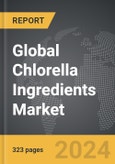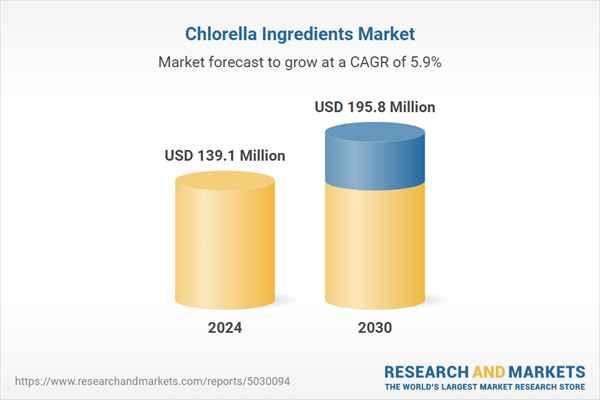The global market for Chlorella Ingredients was valued at US$139.1 Million in 2024 and is projected to reach US$195.8 Million by 2030, growing at a CAGR of 5.9% from 2024 to 2030. This comprehensive report provides an in-depth analysis of market trends, drivers, and forecasts, helping you make informed business decisions. The report includes the most recent global tariff developments and how they impact the Chlorella Ingredients market.
Segments: End-Use (Food & Beverage, Animal Feed, Dietary Supplements, Other End-Uses).
Geographic Regions/Countries: World; United States; Canada; Japan; China; Europe (France; Germany; Italy; United Kingdom; Spain; Russia; and Rest of Europe); Asia-Pacific (Australia; India; South Korea; and Rest of Asia-Pacific); Latin America (Argentina; Brazil; Mexico; and Rest of Latin America); Middle East (Iran; Israel; Saudi Arabia; United Arab Emirates; and Rest of Middle East); and Africa.
The analysts continuously track trade developments worldwide, drawing insights from leading global economists and over 200 industry and policy institutions, including think tanks, trade organizations, and national economic advisory bodies. This intelligence is integrated into forecasting models to provide timely, data-driven analysis of emerging risks and opportunities.
Global Chlorella Ingredients Market - Key Trends and Drivers Summarized
What Makes Chlorella Ingredients So Special?
Chlorella, a type of single-celled green algae, has become a focal point in the health and wellness industry due to its dense nutritional profile. Unlike many other superfoods, chlorella contains an exceptional concentration of vitamins, minerals, and amino acids, along with a significant amount of chlorophyll, which aids in detoxification and immune system support. Its nutritional powerhouse status is attributed to its high levels of proteins, including all nine essential amino acids, making it a plant-based protein source favored by vegetarians and vegans. Additionally, chlorella is rich in omega-3 fatty acids, contributing to cardiovascular health, while its nucleic acid content, particularly RNA and DNA, supports cellular repair and regeneration, promoting overall longevity. Another distinguishing feature is chlorella's ability to bind to heavy metals and toxins, assisting the body in detoxification processes. This unique combination of nutrients and detoxifying capabilities sets chlorella apart from other algae-based ingredients like spirulina. As a result, chlorella is increasingly being integrated into various dietary supplements, functional foods, and even skincare products, providing a holistic approach to health and wellness.How Are Chlorella Ingredients Processed for Consumption?
While chlorella’s nutritional benefits are impressive, its journey from raw algae to a consumable ingredient involves several complex processing steps due to its indigestible cell wall. Chlorella’s cell wall is robust and cannot be broken down by the human digestive system, so innovative techniques are employed to enhance its bioavailability. One of the most common methods is high-pressure homogenization, where the algae are subjected to extreme pressure to break open the cell walls, making the nutrients accessible. Alternatively, some manufacturers use enzymatic treatments or fermentation processes that naturally degrade the cell wall, preserving the algae's maximum nutrient content. Once processed, chlorella is available in multiple forms, such as powders, tablets, capsules, and extracts, making it versatile for various applications. The quality and safety of these products are paramount, especially since chlorella can absorb environmental toxins from the water it grows in. Therefore, chlorella used for supplements and food products must be rigorously tested for contaminants like heavy metals, and sourcing from clean, freshwater environments is critical to ensuring its purity. These stringent processing and quality control measures ensure that chlorella maintains its high nutritional value while meeting safety standards for consumer use.What Are the Key Applications of Chlorella Ingredients Across Industries?
The application of chlorella ingredients extends far beyond traditional health supplements, raising the question: how has this algae found its way into such diverse industries? In the food and beverage sector, chlorella is increasingly being used in functional foods such as protein bars, smoothies, and health drinks due to its rich profile of nutrients, particularly its high protein content and essential fatty acids. Chlorella’s natural green color also makes it an appealing additive for food products seeking natural coloring solutions. In the beauty and personal care industry, chlorella’s antioxidant properties have led to its incorporation in skincare products like anti-aging creams, face masks, and serums. It is valued for its ability to support collagen production, reduce inflammation, and protect against environmental stressors, making it an ideal ingredient for products aimed at improving skin health. Beyond human health, chlorella is making strides in the animal nutrition industry as well, where it is used as a supplement in livestock feed and aquaculture. The algae’s high protein content and its ability to boost the immune system in animals have made it a popular choice for enhancing animal health and productivity. Furthermore, there is ongoing research into the use of chlorella in bioplastics and sustainable packaging solutions, leveraging its renewable nature and biodegradability to reduce environmental impact. This versatility in application demonstrates the far-reaching potential of chlorella ingredients across multiple sectors.What Factors Are Driving the Growth in the Chlorella Ingredients Market?
The growth in the chlorella ingredients market is driven by several factors that reflect changing consumer behaviors, technological innovations, and the expanding application of chlorella in various industries. One of the key drivers is the increasing consumer demand for plant-based and sustainable nutrition, as more individuals seek alternatives to animal-derived products. Chlorella’s high protein content and rich nutrient profile make it an ideal candidate for meeting this demand, especially in the growing vegan and vegetarian markets. Additionally, the rise of clean-label products, where consumers prefer natural, minimally processed ingredients, has further propelled the demand for chlorella. Its reputation as a natural, organic, and non-GMO ingredient aligns perfectly with these clean-label preferences. Another significant driver is the booming functional foods and dietary supplements industry, particularly in regions such as North America and Europe, where consumers are increasingly looking for superfoods that provide comprehensive health benefits in convenient formats. Technological advancements in chlorella cultivation and processing have also played a crucial role in market growth. Improved cultivation techniques, such as controlled indoor farming and closed-system photobioreactors, allow for more efficient production of chlorella with higher nutrient density and lower contamination risks. Furthermore, advancements in extraction and processing methods have made it easier to integrate chlorella into a wide range of products, from supplements to skincare formulations, without losing its nutritional potency. Lastly, growing awareness of sustainability and environmental impact has driven the interest in chlorella as a renewable and eco-friendly resource, not only for food and supplements but also in emerging areas like biodegradable plastics. All these factors combined are fueling the rapid growth and diversification of the chlorella ingredients market.Report Scope
The report analyzes the Chlorella Ingredients market, presented in terms of units. The analysis covers the key segments and geographic regions outlined below.Segments: End-Use (Food & Beverage, Animal Feed, Dietary Supplements, Other End-Uses).
Geographic Regions/Countries: World; United States; Canada; Japan; China; Europe (France; Germany; Italy; United Kingdom; Spain; Russia; and Rest of Europe); Asia-Pacific (Australia; India; South Korea; and Rest of Asia-Pacific); Latin America (Argentina; Brazil; Mexico; and Rest of Latin America); Middle East (Iran; Israel; Saudi Arabia; United Arab Emirates; and Rest of Middle East); and Africa.
Key Insights:
- Market Growth: Understand the significant growth trajectory of the Food & Beverage End-Use segment, which is expected to reach US$138.0 Million by 2030 with a CAGR of a 5.2%. The Animal Feed End-Use segment is also set to grow at 6.6% CAGR over the analysis period.
- Regional Analysis: Gain insights into the U.S. market, valued at $36.0 Million in 2024, and China, forecasted to grow at an impressive 8.9% CAGR to reach $45.5 Million by 2030. Discover growth trends in other key regions, including Japan, Canada, Germany, and the Asia-Pacific.
Why You Should Buy This Report:
- Detailed Market Analysis: Access a thorough analysis of the Global Chlorella Ingredients Market, covering all major geographic regions and market segments.
- Competitive Insights: Get an overview of the competitive landscape, including the market presence of major players across different geographies.
- Future Trends and Drivers: Understand the key trends and drivers shaping the future of the Global Chlorella Ingredients Market.
- Actionable Insights: Benefit from actionable insights that can help you identify new revenue opportunities and make strategic business decisions.
Key Questions Answered:
- How is the Global Chlorella Ingredients Market expected to evolve by 2030?
- What are the main drivers and restraints affecting the market?
- Which market segments will grow the most over the forecast period?
- How will market shares for different regions and segments change by 2030?
- Who are the leading players in the market, and what are their prospects?
Report Features:
- Comprehensive Market Data: Independent analysis of annual sales and market forecasts in US$ Million from 2024 to 2030.
- In-Depth Regional Analysis: Detailed insights into key markets, including the U.S., China, Japan, Canada, Europe, Asia-Pacific, Latin America, Middle East, and Africa.
- Company Profiles: Coverage of players such as Aurora, Cellana Inc., Corbion Biotech Inc., FEBICO (Far East Bio-Tec Co., Ltd.), Fuqing King Dnarmsa Spirulina Co., Ltd. and more.
- Complimentary Updates: Receive free report updates for one year to keep you informed of the latest market developments.
Some of the 46 companies featured in this Chlorella Ingredients market report include:
- Aurora
- Cellana Inc.
- Corbion Biotech Inc.
- FEBICO (Far East Bio-Tec Co., Ltd.)
- Fuqing King Dnarmsa Spirulina Co., Ltd.
- Heliae
- Pharmafreak
- Phytomer
- Roquette
- Tianjin Norland Biotech Co., Ltd.
Tariff Impact Analysis: Key Insights for 2025
Global tariff negotiations across 180+ countries are reshaping supply chains, costs, and competitiveness. This report reflects the latest developments as of April 2025 and incorporates forward-looking insights into the market outlook.The analysts continuously track trade developments worldwide, drawing insights from leading global economists and over 200 industry and policy institutions, including think tanks, trade organizations, and national economic advisory bodies. This intelligence is integrated into forecasting models to provide timely, data-driven analysis of emerging risks and opportunities.
What’s Included in This Edition:
- Tariff-adjusted market forecasts by region and segment
- Analysis of cost and supply chain implications by sourcing and trade exposure
- Strategic insights into geographic shifts
Buyers receive a free July 2025 update with:
- Finalized tariff impacts and new trade agreement effects
- Updated projections reflecting global sourcing and cost shifts
- Expanded country-specific coverage across the industry
Table of Contents
I. METHODOLOGYII. EXECUTIVE SUMMARY2. FOCUS ON SELECT PLAYERSIII. MARKET ANALYSISIV. COMPETITION
1. MARKET OVERVIEW
3. MARKET TRENDS & DRIVERS
4. GLOBAL MARKET PERSPECTIVE
UNITED STATES
CANADA
JAPAN
CHINA
EUROPE
FRANCE
GERMANY
ITALY
UNITED KINGDOM
SPAIN
RUSSIA
REST OF EUROPE
ASIA-PACIFIC
AUSTRALIA
INDIA
SOUTH KOREA
REST OF ASIA-PACIFIC
LATIN AMERICA
ARGENTINA
BRAZIL
MEXICO
REST OF LATIN AMERICA
MIDDLE EAST
IRAN
ISRAEL
SAUDI ARABIA
UNITED ARAB EMIRATES
REST OF MIDDLE EAST
AFRICA
Companies Mentioned (Partial List)
A selection of companies mentioned in this report includes, but is not limited to:
- Aurora
- Cellana Inc.
- Corbion Biotech Inc.
- FEBICO (Far East Bio-Tec Co., Ltd.)
- Fuqing King Dnarmsa Spirulina Co., Ltd.
- Heliae
- Pharmafreak
- Phytomer
- Roquette
- Tianjin Norland Biotech Co., Ltd.
Table Information
| Report Attribute | Details |
|---|---|
| No. of Pages | 323 |
| Published | April 2025 |
| Forecast Period | 2024 - 2030 |
| Estimated Market Value ( USD | $ 139.1 Million |
| Forecasted Market Value ( USD | $ 195.8 Million |
| Compound Annual Growth Rate | 5.9% |
| Regions Covered | Global |









